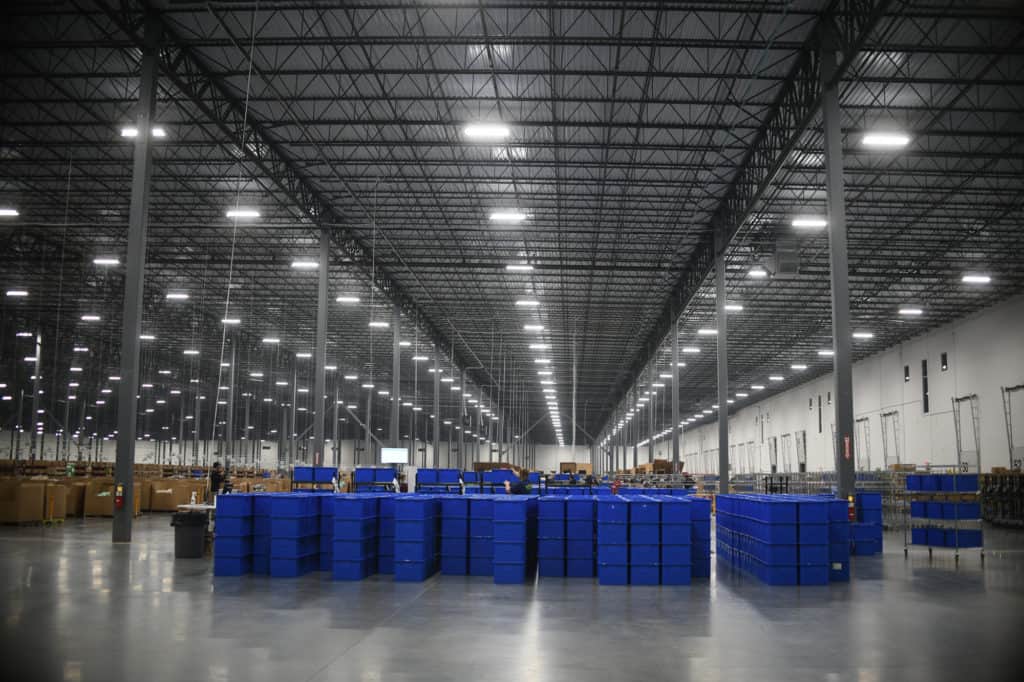Every warehouse operator’s goal is to ensure that goods flow efficiently in and out of the facility. There are a variety of factors that can hinder the flow of products through a warehouse, from inadequate replenishment processes to order picking inefficiencies. A floor plan that makes navigation difficult or makes it necessary for warehouse associates to travel long distances to complete common tasks can impact all of these workflows, reducing the overall efficiency of your operation. A warehouse floor plan that’s designed to maximize efficiency, on the other hand, supports streamlined workflows and processes that help warehouse operators meet their goals.
There’s no universal warehouse floor plan that works for every warehouse operation. Extra-wide aisles may work for one facility that has a constant two-way flow of traffic consisting of both human associates and heavy equipment. For another facility, however, extra-wide aisles may take up much-needed floor space that would be better used for storage. While there’s no one-size-fits-all floor plan, there are a few best practices to keep in mind that will help you create a warehouse floor plan that maximizes efficiency.
Identify needs and current shortcomings

The first step in creating a warehouse floor plan to maximize efficiency is to consider your needs, such as the order fulfillment methods you plan to implement, space utilization and storage requirements. Consider the type of inventory you store, product sizes and other physical characteristics, how much stock you’ll store and where inventory arrives and departs the facility.
If you’re reorganizing an existing warehouse, identifying inefficiencies in your current design is a good starting point. For example, one common warehouse layout issue is poorly configured pick faces, leading associates to back-track to retrieve items instead of following more efficient pick routes. Even the most optimized pick routes should be reevaluated periodically, as product lines, storage organization and picking methods can change over time.
Another common issue is storing frequently picked items in bulk storage areas. If your associates are frequently retrieving products from bulk storage and moving them to replenish picking locations, moving those high-velocity items to the floor can reduce the number of touches – a key factor in efficient warehouse operations. Likewise, long rows of warehouse racks with few to no cross-aisles often means your associates are spending more time walking than necessary. Redesigning your warehouse floor plan to incorporate ample cross aisles helps to reduce the long walk.
Design your warehouse floor plan for uninterrupted flow
Warehouse blueprints that allow for the uninterrupted flow of people, materials, and equipment support efficiency by reducing heavy traffic congestion in aisles. Plan your warehouse floor plan so that sequential activities are located nearby. For example, plan space for sorting near packaging and shipping areas, so that products don’t have to travel across the facility for each subsequent step.
Visuals like warehouse floor plan schematics and design software are helpful for determining the best floor plan design for flow. Whether you use a software program or simple grid paper, drawing a schematic at scale will help you visualize workflows and determine the best locations for storage, receiving, sorting, packaging and shipping.
Allocate space for equipment and workstations

The type of warehouse equipment you use is a big consideration when creating a warehouse floor plan. Equipment such as conveyor systems take up a significant amount of space and are fixed in place. As a result, warehouses with conveyor systems often must plan their floor plan around the equipment, and making changes to the layout later to improve efficiency can prove challenging.
Warehouses that rely on more flexible automation technology, such as collaborative mobile robots, have greater design flexibility compared to traditional automation solutions like conveyor systems and automated storage and retrieval systems (AS/RS). They take up much less space compared to bulky conveyor systems, and they’re not fixed in place. Collaborative robots can easily navigate any type of warehouse layouts and require no changes to your infrastructure, making them a suitable choice for warehouses that need the flexibility to redesign their floor plans to accommodate new product lines or other changes.
Collaborative mobile robots like Chuck by 6 River Systems make decisions in real-time based on current work assignments and the status of the warehouse floor. Chuck leverages AI and machine learning to optimize pick routes and reduce unnecessary walking to help your associates do more in less time, solving several common warehouse challenges in one flexible solution.
When creating your warehouse floor plan, consider the type of equipment used, its space requirements, and other considerations such as the aisle width required for equipment access.
Ensure that all products and pallets are accessible
When creating a warehouse floor plan, design storage areas so that all products and pallets are accessible without the need to move other products out of the way. That means that pallet storage areas have aisles wide enough to accommodate forklifts and pallet jacks.
Other products should be stored strategically to maximize accessibility. Warehouses using traditional pick methods benefit from storing higher-velocity products in the most accessible areas and near sorting, packaging and shipping workstations. Warehouses that handle seasonal products should plan for reorganizing storage to place current seasonal products in the most accessible locations and moving out-of-season products to less-accessible or long-term storage areas.
Test your warehouse floor plan before implementation
If you have the luxury of working with an open warehouse space, you can test your floor plan design by marking key areas with tape and conducting mock workflows to ensure that processes and goods can flow smoothly after warehouse racks, shelves and equipment are on-site.
If you’re limited to a schematic, reconfirm all measurements and ensure that all areas and workstations have the appropriate space and aisles are sufficiently wide to accommodate traffic (both human and equipment). Keep workflows in mind and trace the flow of products from receiving to shipping to ensure that there are no unnecessary interruptions. Modern fulfillment operations use digital twin models of their site to simulate real-time layout changes using historical data.
Your warehouse floor plan and layout pattern can make or break your operation’s efficiency, so it’s worth taking the time to carefully evaluate every factor and weigh every consideration in the design process. Implementing more flexible automation solutions like collaborative mobile robots allows warehouse operators to reorganize floor plans to accommodate change without costly investments in infrastructure overhauls. When considering your floor plan design, keep not only your current needs in mind, but also the ability to adapt to future growth. Interested in more? Let’s discuss the solution that’s right for you. Contact us today.


